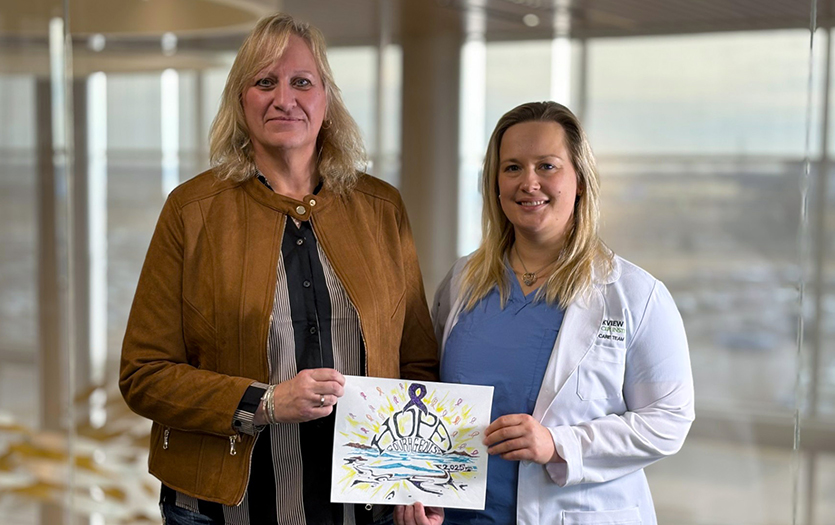
This post was written by Breck Hunnicutt, NP-C, High Risk and Cancer Risk Reduction Program, Parkview Cancer Institute.
An ounce of prevention is worth a pound of cure. We have all heard this adage about our health and the importance of adopting a healthy lifestyle for wellness and reducing the risk for certain illnesses and diseases. This also applies to cancer. Determining the best plan for reducing your risk for cancer is like putting a puzzle together. It’s important to know your physical conditions, family history and genetic characteristics. The many pieces of this puzzle will help reveal the bigger picture for your health care.
Personal traits
Usually, it’s impossible to know precisely why a person develops cancer, but certain risk factors can lead to an increased risk. Avoiding some risk factors might be easy, while it’s more challenging to circumvent others. We refer to these as modifiable and non-modifiable risk factors. Let’s take a look at each category and the elements within it:
Modifiable risk factors
- Tobacco use
- Alcohol use
- Diet
- Activity
- Ultraviolet radiation from the sun or indoor tanning
- Cancer-causing substances
- HPV infection
- Chronic inflammation
- Reflux
- Extended hormone replacement use
Non-modifiable risk factors
- Age (getting older)
- Weakened immune system
- Radiation
- Family history
- Personal history of cancer
- Genetic mutation
- Gender
- Ethnicity
- Long menstrual history
- Reproductive history
- Diabetes
- HIV
- Barrett’s Esophagus
Many of these risk factors, both modifiable and non-modifiable, can be managed to reduce your risk of developing cancer.
Family history
Your family health history is a compilation of your blood relatives' cancer diagnosis. When your health team asks about your family history, think of your first-, second- and third-degree relatives, both living and deceased. To do that, let's first define what the different degrees are:
- First-degree relatives: The first includes your children, parents, brothers and sisters.
- Second-degree relatives: The second includes aunts, uncles, grandparents, grandchildren, nieces, nephews and half-siblings.
- Third-degree relatives: The third includes cousins, great aunts, great uncles and great grandparents.
Additionally, there are three questions I recommend people asking every relative. They include:
- What cancer did each relative have?
- How old were they when diagnosed?
- How old are they now, or how old were they at the time of death?
Don’t be afraid to ask your relatives questions and write everything down. All families have a couple of members who are record keepers. If you need help keeping track of everything, the surgeon general has an online tool called My Family Health Portrait, where you can collect, save and share your family health information.
Some relatives may be hesitant to share this type of information. It’s important to remember that in the past, people did not discuss their cancer history. It may have been taboo or just seen as impolite. We previously didn’t realize we could use family history to predict cancer, so there was no reason to share one’s personal health information. So, if your family member seems reluctant to discuss things, ask them why and be sure to share your motivation and reasons for investigating.
Genetic testing
Genetic testing can detect mutations in your DNA inherited through a mother and/or father. Many of these mutations can increase your risk for different kinds of cancer treatment. There are a variety of syndromes associated with genetic mutations, including but not limited to:
- Lynch Syndrome
- Familial Adenomatous polyposis (FAP)
- Attenuated familial Adenomatous polyposis (AFAP)
- MUTYH-Associated Polyposis (MAP)
- Peutz-Jeghers Syndrome (PJS)
- Juvenile Polyposis Syndrome (JPS)
- Serrated Polyposis Syndrome (SPS)
- Li-Fraumeni Syndrome
- Cowden Syndrome/PTEN Hamartoma Syndrome
- Pancreatic Cancer Susceptible genes
- High-Penetrance Breast and Ovarian Cancer Susceptibility Genes
When a cancer-causing genetic mutation is identified, treatment and screening guidelines may change to reduce the risk of developing cancer or detect it early for the opportunity for improved outcomes. There are different reasons to obtain genetic counseling and testing. Some of these reasons can include:
- To learn if a genetic condition runs in the family.
- To understand the chance of passing this mutation to your children or future children.
- To help develop your screening and possible intervention plan based on the risk associated with a genetic mutation if present.
It’s best to participate in genetic counseling with a certified genetic counselor before testing so you receive accurate and thorough information. This will allow you to make an informed decision on whether genetic testing is right for you.
Cancer screening and increased risk
When a person identifies as having an increased chance of cancer due to a personal history of cancer, a family history of cancer, or a genetic mutation, there are often recommendations to receive increased screenings from the average risk person. When you are told you carry an increased chance of developing cancer, they refer to the probability that cancer may occur, but this does not guarantee you will develop cancer. Risk is calculated by studying many people with similar characteristics and comparing cancer incidence to a large group without these characteristics. This allows researchers to determine the probability that a particular category of people will develop cancer.
Once they find the probability, they will complete further research to determine the appropriate screening and risk reduction recommendations. These recommendations will help reduce the risk of certain cancers from occurring or enable a cancer diagnosis at an early stage to improve outcomes.
Reducing your risk
There is no certainty in preventing cancer, but adopting some general risk reduction behaviors can reduce your risk of cancer occurring. These behaviors can include:
- Avoiding all tobacco, including secondhand smoke
- Improving your nutritional intake by reducing saturated fat and red meat, avoiding processed foods, and increasing fruits, vegetables, and whole grains
- Exercising regularly, which can help reduce your risk even if you don’t lose weight
- Limiting alcohol intake by averaging your daily consumption to one drink a day
- Avoiding ultraviolet rays, including sun exposure, and tanning beds
- Avoiding exposure to industrial and environmental toxins, such as asbestos
- Avoiding infections that can contribute to cancer, including hepatitis viruses, HIV and HPV
Additionally, there are several tests and interventions which are available to manage cancer risk. This may include one or more of the following:
- Mammogram with tomosynthesis
- Breast MRI
- Contrasted enhanced breast mammography
- Breast ultrasound
- Bilateral mastectomies with reconstruction
- Removal of ovaries and/or uterus
- HPV vaccine
- Hepatitis B vaccine
- Nutritionist
- Weight management
- Transvaginal ultrasounds
- Thyroid ultrasounds
- Physical exams
- Colonoscopy and intervention to remove polyps
- Chemoprevention strategies
- Endoscopic ultrasound to visualize images of the lining and walls of your digestive tract and chest, nearby organs such as the pancreas and liver, and lymph nodes
- Esophagogastroduodenoscopy
A personalized plan should be created and managed to meet your unique risks based on your characteristics, family history and genetic results, if applicable.
To determine if the Parkview Cancer Institute High Risk and Cancer Risk Reduction Program may be right for you, review our reasons to consider an appointment.



